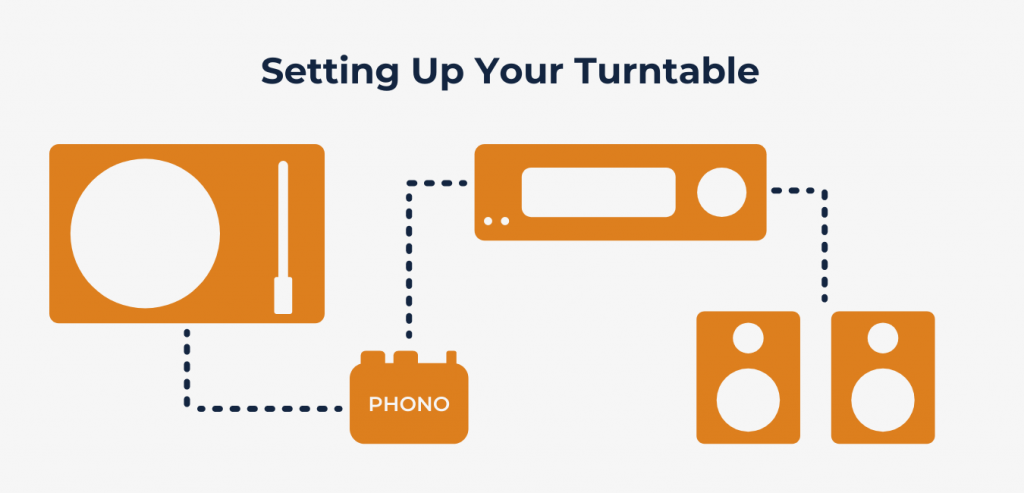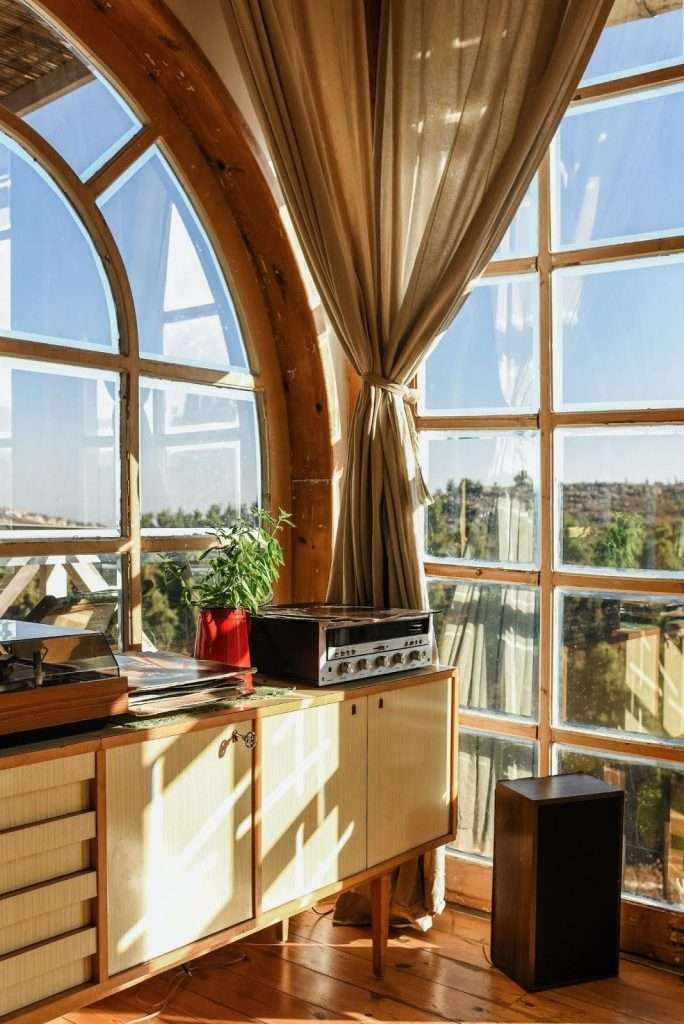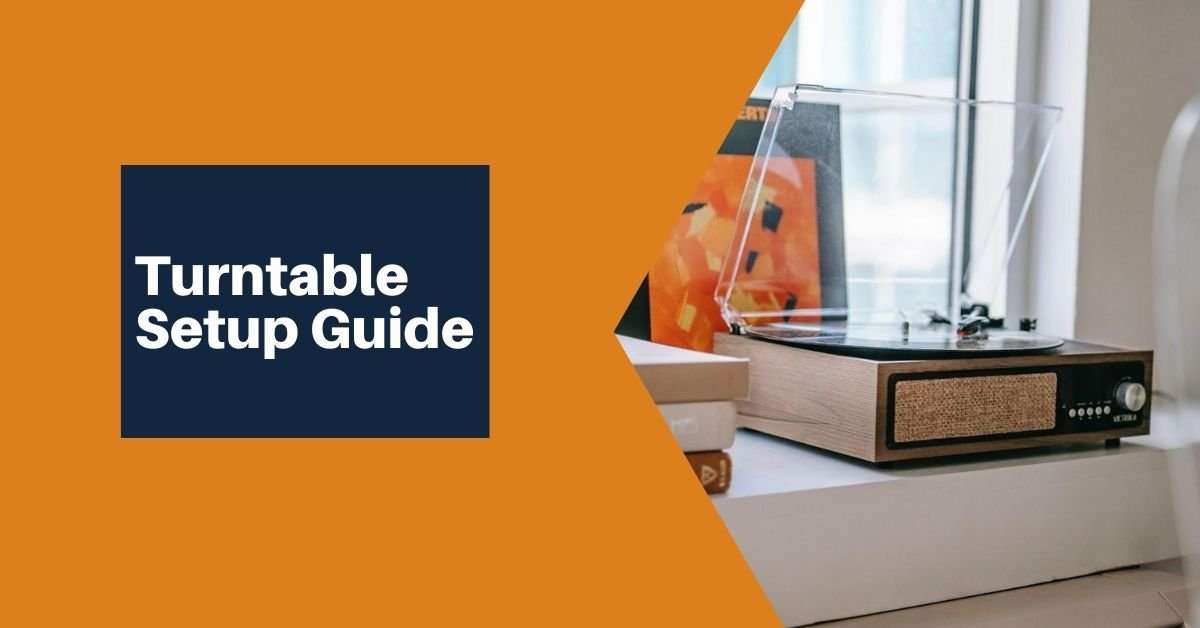Table of Contents
- Extra Items You Might Need
- What is needed for a turntable setup?
- How Do I Setup My Turntable?
- What’s the Right Turntable Setup for You?
- Commonly Asked Questions
The process of setting up your turntable can be very simple depending on what equipment you have. While each listening setup is unique, there are a few things that must remain consistent. We recommend before purchasing any additional gear and equipment, take inventory of what you currently have and attempt to draw out or map your setup before attempting to put it together.
Don’t have a turntable yet? Here are some turntable recommendations under $200!
Now that we know what we have, let’s move forward with the turntable setup guide!
Extra Items You Might Need:
- RCA Stereo Cables
- 16-Gauge Speaker Wire
- Phillips Head Screwdriver
- Wire Strippers or Scissors
What is needed for a turntable setup?

Traditional turntable setups usually consist of 4 major pieces of equipment. While some of these pieces can be combined into one, such as record players with built-in speakers, it’s a good idea to understand the basics first so you can not only expand your setup but your vinyl knowledge.
The Turntable
As to no surprise, the turntable is the first piece of equipment you’ll need for your setup. Turntables come in all shapes in sizes with various features and characteristics. We won’t get into the difference between belt drive and direct drive in this article. For now, just think of the turntable as the equipment that plays your vinyl record.
If it’s a standalone turntable, meaning there are no built-in speakers or volume knobs, you should notice a cord or two dangling from the back. While modern turntables sometimes have additional USB cords, we’re just concerned with the phono cable which looks like your typical RCA cable.
Turntables will also have a small cord with metal prongs called a ground wire. This grounds the electrical signal and prevents unwanted buzzing and humming when listening to music.
There will also be a power cable used to power the turntable on.
Phono Preamp (Phono Stage) – Sometimes Optional
The second piece of equipment that will be needed in some capacity for your turntable setup is a phono preamp AKA phono stage. If you have one of these, great – your bases are covered. If not, don’t worry, it might not be necessary as it’s often a built-in preamp.
What Is A Phono Preamp?
Turntables produce what is called a PHONO output signal. While we won’t go into the nitty-gritty details over the technicals in this guide, just know this PHONO signal must be converted to a line-level signal so it can be played and heard through your speakers. A phono stage converts the PHONO signal into a line-level signal.
These phono preamps can range in price, but typically are a small box you plug your turntable directly into, a knob for your ground wire, and an output for your stereo or speakers.
Do I Need a Preamp and an Amp for My Turntable?
The short answer is no, phono preamps and stereo amplifiers are not always necessary. If you have an all-in-one record player with built-in speakers, you will be able to play music just fine without a phono stage. Additionally, some turntables are manufactured with a built-in preamp. If connected to powered speakers, you will not need a phono stage or stereo amplifier.
An easy way to find out if your turntable has a built-in phono preamp is to look for a switch on the back marked “Phono / Line.” This typically means there is a built-in phono preamp you can toggle on and off. While a turntable preamp is convenient, it’s usually a sign of a lower-quality record player. Being able to toggle phono off in order to use an external phono stage can be an easy way of increasing the sound quality of your record player or turntable quickly.
For stereo receivers, find this by looking at the backside of your stereo for a phono input – a corresponding set of plugs for the RCA cables of your turntable as well as a pin or knob to hold the ground wire.
Vintage stereo systems usually came with a built-in preamp for phono, but as time went on and people lost interest in listening to vinyl records, many manufacturers removed them as they felt they were an outdated piece of technology. Now that vinyl is experiencing newfound interest from younger generations, manufacturers are starting to produce stereo systems with a phono built-in preamp.
Depending on the quality of your stereo system, it can be beneficial to purchase a standalone phono preamp to increase sound quality, loudness, and clarity.
Stereo Receiver
Stereo systems, while at times optional, is highly recommended as it will allow you to craft and equalize the signal coming from your turntable to your speakers. Whether you have a stereo with a built-in phono preamp or you’re running a standalone unit, stereo systems are a great way to easily control the variables of your music such as volume, panning, and EQ.
Additionally, stereos are used to power passive speakers.
As an added bonus, stereos can be multi-purpose entertainment centers and allow you to play audio from your phone, computer, or TV with an aux cord, Bluetooth, or wired connection.
Speakers
The obvious one – it’s how you hear your vinyl record being played! Speakers come in a range of shapes, sizes, and specifications. We won’t get too caught up in that for now, but we do need to cover the difference between active and passive speakers.
What are Active Speakers or Powered Speakers?
Active speakers or powered speakers are speakers that can power themselves without a stereo receiver. These speakers will typically have a volume knob on the back and need to be plugged into a wall outlet.
What are Passive Speakers?
Passive speakers are speakers that cannot power themselves and need an external power source such as a stereo receiver to function. Passive speakers will just have a red and black terminal on the back for 16-gauge speaker wire.
How Do I Setup My Turntable?

The Common Turntable and Preamp Setup
The most common way for standalone turntables to be setup is:
Turntable > Phono Preamp > Stereo Receiver > Speakers
Step 1
First, start with your turntable. Find the 2 RCA cables and plug them into your phono stage.
Make sure your turntable is on a clean and level surface.
Step 2
Next, find the metal prong cable from your turntable. This is the ground wire. Attach this to the back of your phono stage. There’s usually a small adjustable knob or screw that allows for the adjusting of the tightness in order to clamp the wire behind it without it coming loose.
Step 3
Depending on the turntable, attach an additional ground wire from your phono preamp to your receiver. If no ground exists on your receiver, find a screw on the back of your stereo, loosen it, and slot the ground wire under that.
Step 4
Plug an additional set of RCA cables from your preamp’s output to your receiver. Pick any channel, typically there are multiple available.
Step 5
For passive speakers use 16-gauge speaker wire. When looking at the front of your turntable setup, plug the left speaker into the left channel and the right speaker into the right. Black connects to black, red connects to red.
The wire will need to be stripped, typically about 1 inch, to provide solid metal-to-metal contact. Use wire strippers if you have them, otherwise, a knife, plyers, or scissors will work with caution.
If using powered speakers, locate the receivers “pre-out” and plug them in there.
Step 6
Plug in AC power to the receiver, preamp, and turntable if needed. Sometimes stereo receivers will have built-in AC power outlets and it’s suggested to utilize these to save wall space.
Other Turntable Setups
If your current turntable setup is different than what was described above don’t worry, it can still work! Some stereo receivers and turntables come with phono as a built-in preamp which negates the necessity of a phono stage.
Additionally, if you have powered speakers, it’s possible to plug them directly into your phono preamp or even your turntable and receive decent sound quality.
Below we listed a few less common setups. Use the turntable setup guide above to help you if needed.
Turntable with a Built-in Phono Preamp Setup
Turntables with a built-in preamp can be plugged directly into powered speakers or a stereo receiver.
- Turntable > Powered Speakers
- Turntable > Receiver > Speakers
Stereo Receiver with a Built-in Phono Preamp
Stereo receivers with a built-in phono stage can also bypass a step.
- Turntable > Receiver > Speakers
Turntable Setups with No Stereo Receiver
As mentioned above, a stereo receiver is always necessary (though it is recommended). Here are a few scenarios where it could work:
- Turntable with Built-in Phono > Powered Speakers
- Turntable > Phono Preamp > Powered Speakers
What’s the Right Turntable Setup for You?

As you can probably see from above, there are a variety of ways to set up your turntable with different benefits and drawbacks. While many audiophiles will gravitate towards the common setup outlined above, not everyone has the space or money to do that.
We recommend focusing on your turntable first. Getting a high-quality turntable allows you to expand your setup down the road. Next would be speakers. There’s nothing wrong with your setup being a turntable directly to powered speakers. There are many high-quality bookshelf speakers online that produce great sound quality. This is perfect for listeners who live in a college dorm, small apartment, or single room.
Commonly Asked Questions
Why does my turntable or record player sound so quiet?
A: Typically this is due to a lack of a phono preamp. If your vinyl record sounds so quiet you can barely hear it despite turning the volume up, check and make sure either your turntable or stereo has a phono preamp.
Why are my speakers hissing or humming?
A: This is usually due to an issue with your ground wire. Make sure your turntable and preamp are properly grounded with full contact to metal.
Why do my records sound bad and distorted? Scratching, skipping, buzzing, etc.
A: There are many reasons why records might sound bad. It’s important to start at the top and work your way down.
Firstly, is your turntable tonearm balanced? An unbalanced tonearm can cause unnecessary distortion. Click here for a tonearm balancing video.
Second, is your needle and cartridge clean? Visually inspect the needle with a light. Oftentimes, these needles can pick up dust and debris after use – especially with older records.
Third, is your system properly grounded? Check all ground points to ensure metal-on-metal contact.
Lastly, is the record in decent shape? Scratches, scuffs, and dust can drastically affect the sound quality of vinyl, especially with vintage vinyl records.
What’s the difference between a record player and a turntable?
There’s a dramatic difference between record players and turntables. The words record player and turntable are often used synonymously but they shouldn’t be. Turntables are standalone units that need a preamp and speakers to produce sound, record players are an all-in-one device.

Lead Editor / Owner
After beginning his career in the video and audio recording industry, Andrew started HiFi Hippo to share his knowledge and passion for vinyl and vintage audio with other readers.
